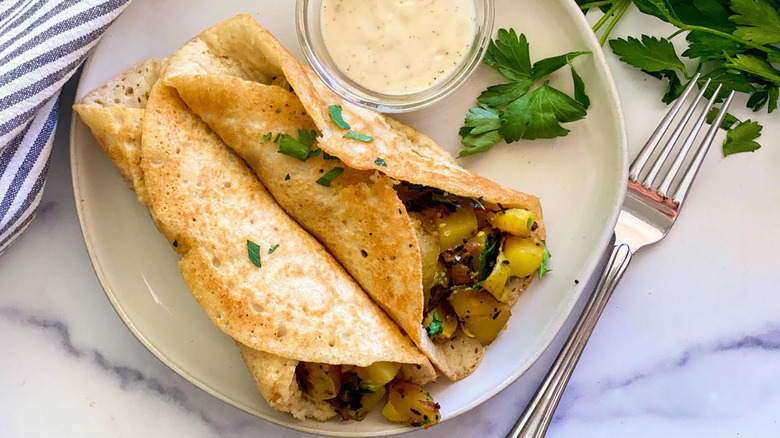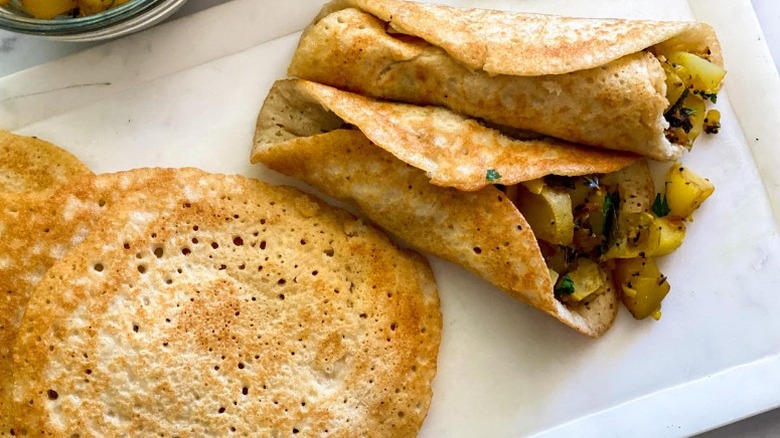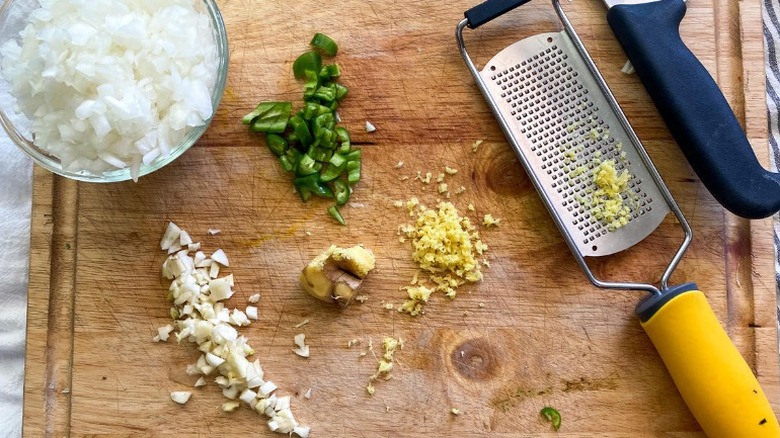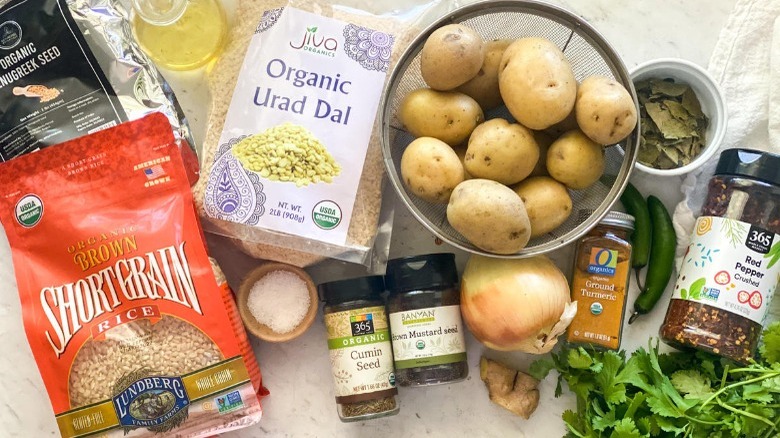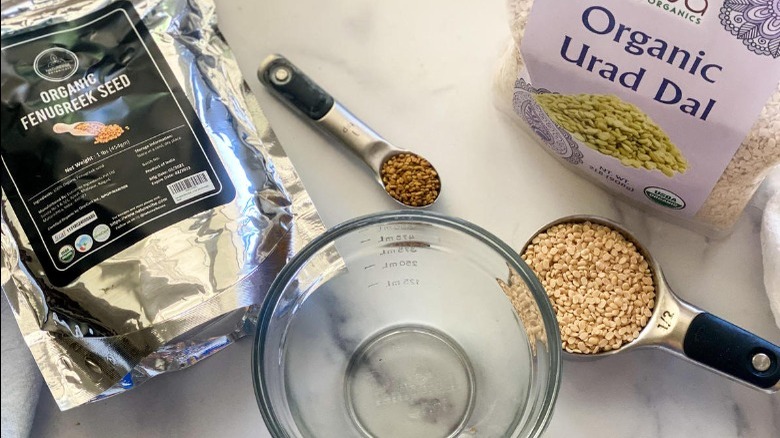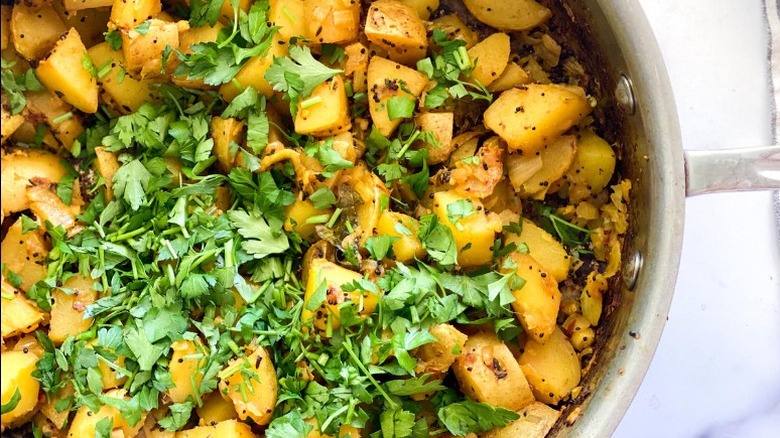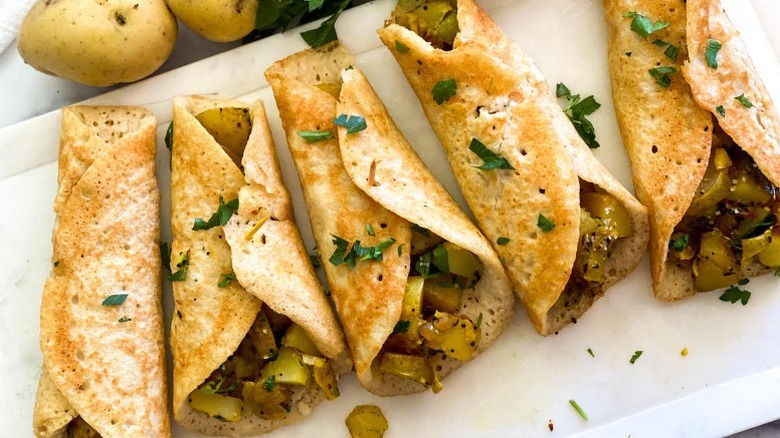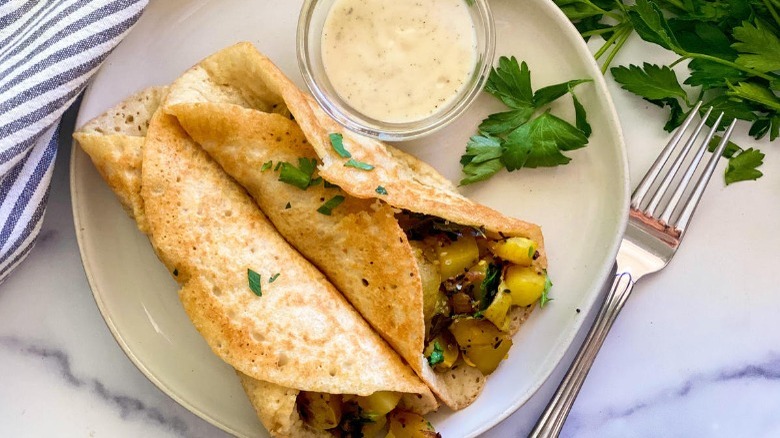Classic Masala Dosa Recipe
When you're craving some Indian food, you may find yourself going for the classic dishes you're used to ordering, like butter chicken, rice, and naan. While those may be comforting and delicious, there's a large, diverse array of other mouthwatering Indian and South Asian dishes just waiting for you to dig into. Trust us: if you haven't had one, you're overdue for a dosa, which can be best thought of as a kind of savory Indian crepe.
Recipe developer and wellness coach Miriam Hahn's classic masala dosa is comforting and flavorful, packed with fragrant spices and filled with seasoned potatoes and bright cilantro. It's also vegetarian, so if you've been looking for a dish to make that will delight and impress your meat-free guests, this is an excellent pick.
"I first had dosas at an Indian restaurant and loved them, so I decided to try them at home! I love experimenting with international dishes at home," Hahn explains. If you've never cooked Indian food at home before, making masala dosa is a great place to start. This is not a 5-ingredient, one-pot, 30-minute meal to whip up last-minute; it's a multi-step project that should be done over the course of a day or even two. But don't be intimidated by the lengthy amount of seasonings and time. All the steps are relatively simple, and the end result will be well worth it.
What is a dosa?
There are many varieties of flatbread to be enjoyed in South Asian cuisine: soft naan, flaky paratha, tortilla-like chapati, and whole wheat roti, to name a few. Dosas are thin breads that resemble a crepe, and are commonly stuffed with a savory filling and eaten as street food or breakfast food (via Sukhi's). The batter is made from a mixture of ground rice, dal, and salt.
Masala dosa is a popular type of dosa, and is distinguished by what's in its batter. According to Sukhi's, masala dosa is one of the most common dosa varieties, and in addition to the classic foundation of rice and lentil flour, contains fenugreek, potato, and curry leaves.
Get your dosa ingredients ready
Making masala dosa doesn't just require several hours of your time, it also requires a lot of ingredients. So it's important to make sure you have everything you need before you get started. For the dosa itself, you'll need 2 cups of short grain rice (brown or white will do, just make sure it's short grain), ½ cup of urad dal, 1 teaspoon of fenugreek seeds, 1 teaspoon of salt, and water, plus neutral oil to cook them in.
For the potato filling, you'll need 10-12 small Yukon potatoes cut into bite-sized pieces, neutral cooking oil, 2 diced green chilis (like serranos or jalapenos), 1 diced onion, 3 cloves of minced garlic, 1 teaspoon of mustard seeds, ½ teaspoon of cumin seeds, ½ teaspoon of turmeric, ¼ teaspoon red pepper flakes, 8 curry leaves, 1 tablespoon of fresh grated ginger, and about ½ cup of chopped cilantro.
That's a lot of spices!
"I love using lots of spices, so I have a well-stocked spice cabinet," Hahn says, but acknowledges that the ingredients list can look daunting to someone less experienced in the world of international seasonings. Obviously, the dish works best with everything the recipe calls for, but not being able to get your hands on every herb, seed, and spice listed won't prevent you from making it.
Hahn offers some reassuring advice: "You can easily substitute 1 teaspoon of curry powder for the curry leaves if you don't have those. For the spices that are in seed form like cumin, mustard, and fenugreek, you can easily substitute ground or feel free to leave out one or two if you don't have them. As long as you have at least three of the spices in any combination, it will be good."
Make the dosa batter
Dosa batter is made from whole rice and lentils, so your first step is soaking everything for a while. Place your rice in one bowl, and your urad dal and fenugreek seeds in another. Add 4 cups of water to the rice bowl and 1 cup of water to the dal bowl, cover both bowls, and wait 4-6 hours.
"Soaking the dal and seeds makes them soft enough to create the batter as you are not cooking them prior," recipe developer Miriam Hahn explains. "As an alternative, you can avoid using whole rice and urad dal and instead use 3 cups rice flour and 1 cup urad dal flour. This saves quite a bit of time."
When you're done soaking, drain and rinse the contents of each bowl separately. Blend the rice for about eight minutes in a food processor with 1 cup of water until smooth, remove it from the food processor, and set it aside. Then, do the same with the dal and fenugreek seed mixture. Put both blended mixtures in a big bowl with ½ teaspoon of salt. Give it a good mix, cover the bowl, and let it rest on the counter for eight hours.
Make the dosa filling
Now, for the filling. First, heat some oil in a large skillet (Hahn recommends avocado oil, olive oil, or vegetable oil). When it's hot, add the cumin and mustard seeds and cook them for 1-2 minutes, so they pop and get fragrant. Then, add the ginger, garlic, green chili, and onion and cook for an additional five minutes, stirring occasionally.
After that, add the red pepper flakes, turmeric, curry leaves, and the remaining ½ teaspoon of salt. Give everything a stir, then add the potatoes. On medium heat, cook everything for between 15 and 25 minutes — you want to make sure the potatoes get nice and soft. When they look done, add in the chopped cilantro and a bit more salt if you feel the dish needs it.
Cook the batter and assemble the dosas
Now that your dosa batter is good and ready, it's time to turn it into some delicious crepes. Get out a nonstick skillet or castiron skillet, add a teaspoon of oil, and turn the heat to medium. After the pan is warm, use a ladle to pour about ¼ cup of batter into the pan, spreading it out in a thin layer about six to seven inches in diameter. (Feel free to use a spatula to help with this.) Drizzle a tiny bit of oil on top, and let it cook for about two minutes. It should bubble like a pancake and develop brown, crisp edges. After about two minutes, use a spatula to remove the dosa from the pan; since it's so thin, you don't need to flip it. Repeat this process until all the batter is used.
Finally, assemble the dish by spooning about ⅓ cup of the potato filling into each pancake and wrap it in a way that creates a cone-like shape, with one end wrapped tightly and the other end more full of potatoes. Top everything with a sprinkle of cilantro, and that's it!
Time to dig into some dosas
At last, it's finally time to taste the fruits of your labor. After all that hard work, you're ready to dig in! This recipe makes 16 dosas (or eight servings), so it's a great choice if you're having people over or have a big family to feed. "For leftovers it is best to store the dosas and masala separate and just roll right before eating," recipe developer Miriam Hahn suggests, and notes that "the masala is great alone too if you want to make that separate and skip the dosas."
"I usually serve this with rice and a green salad," Hahn says, but if you don't have the energy to whip up even a single side dish after making these dosas, you're in luck. Hahn notes the dish "is a complete balance of protein, fat, and fiber, so it is fine to serve on its own." Happy eating!
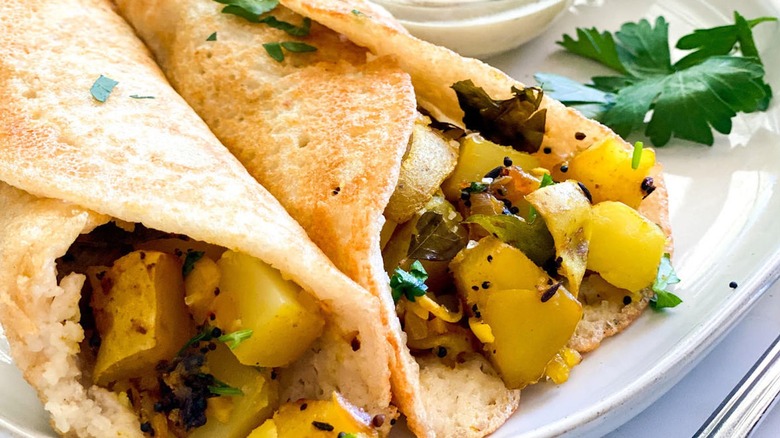
- 2 cups short-grain rice
- ½ cup urad dal
- 1 teaspoon fenugreek seeds
- 6-7 cups water, divided
- 1 teaspoon salt, divided
- ½ cup oil, divided
- 1 onion, chopped
- 3 garlic cloves, minced
- 1 tablespoon fresh ginger, grated
- 10-12 small Yukon potatoes, chopped
- 2 green chilis, diced (I used Serrano)
- 1 teaspoon mustard seeds
- ½ teaspoon cumin seeds
- ½ teaspoon turmeric
- ¼ teaspoon red pepper flakes
- 8 curry leaves
- ½ cup cilantro, chopped
- Put the rice in a bowl with 4 cups water. Put urad dal and fenugreek seeds in a separate bowl with 1 cup of water. Cover both bowls and soak for 4-6 hours.
- After the mixtures are done soaking, rinse in separate strainers. Add drained rice to a food processor with 1 cup water and blend for about 8 minutes until completely smooth. Set aside and rinse out food processor. Add drained urad dal and fenugreek with 1 cup water to food processor and blend for 8 minutes until smooth.
- Combine both mixtures in large bowl. Add 1/2 teaspoon salt and mix again. Cover and let dosa batter sit on the counter for 8 hours.
- Add oil to a large skillet and when hot, add the cumin and mustard seeds. They will start to pop. Cook for about 1-2 minutes. Then add in onion, garlic, ginger, and green chilis and cook for 5 minutes.
- Add the turmeric, red pepper flakes, and the remaining 1/2 teaspoon of salt, and curry leaves to the pan and stir. Now add the chopped potatoes and cook for about 15-25 minutes on medium until potatoes are soft. Add in cilantro and more salt if needed.
- When the dosa batter is done, add 1 teaspoon of oil to a non-stick skillet or cast-iron skillet on medium heat. Ladle about ¼ cup of the batter into the pan and spread out the batter with the ladle or a spatula so it is about 6 or 7 inches in diameter. Add a drizzle of oil to the top of the dosa pancake. Cook for about 2 minutes. The dosa will have brown outer edges and have lots of bubbles. Bottom should be brown and crisp. Remove from pan without flipping and drop in another ¼ cup of batter.
- Repeat until all of the dosas are made.
- Spoon about 1/3 cup of the potato filling into each dosa and wrap in a cylinder shape making one end tight and narrow and the other wide.
- Top with more cilantro and serve.
| Calories per Serving | 542 |
| Total Fat | 15.1 g |
| Saturated Fat | 1.3 g |
| Trans Fat | 0.1 g |
| Cholesterol | 0.0 mg |
| Total Carbohydrates | 91.4 g |
| Dietary Fiber | 7.5 g |
| Total Sugars | 4.5 g |
| Sodium | 318.8 mg |
| Protein | 11.3 g |
